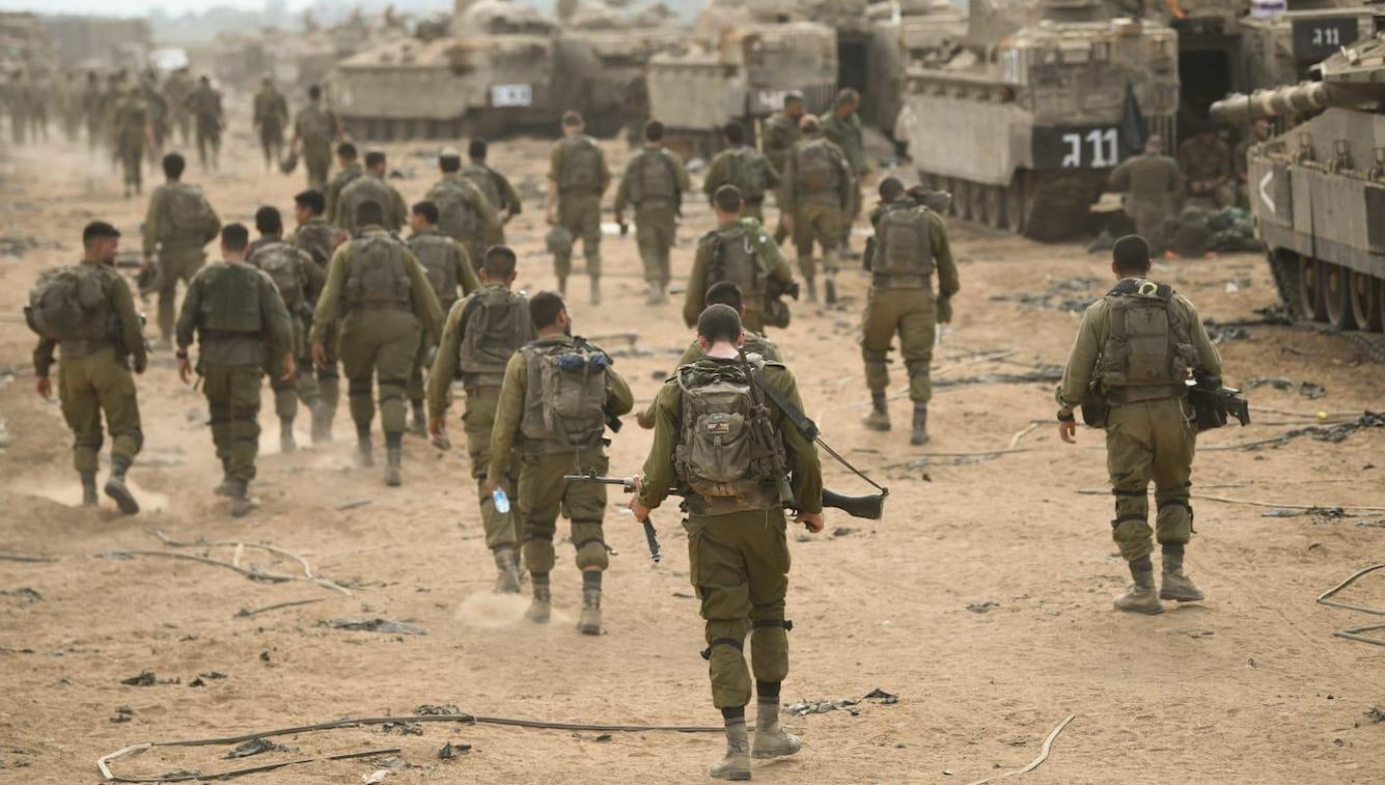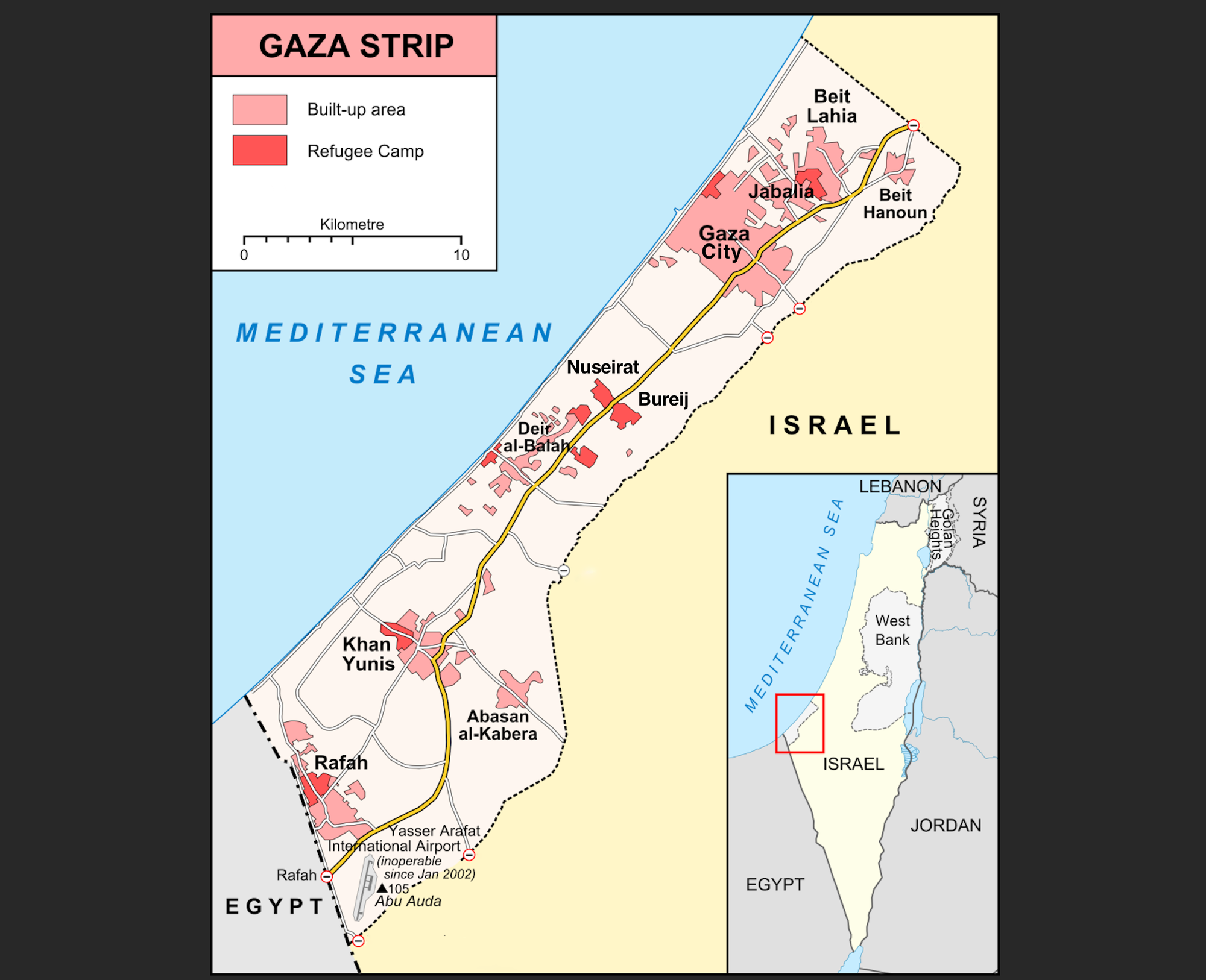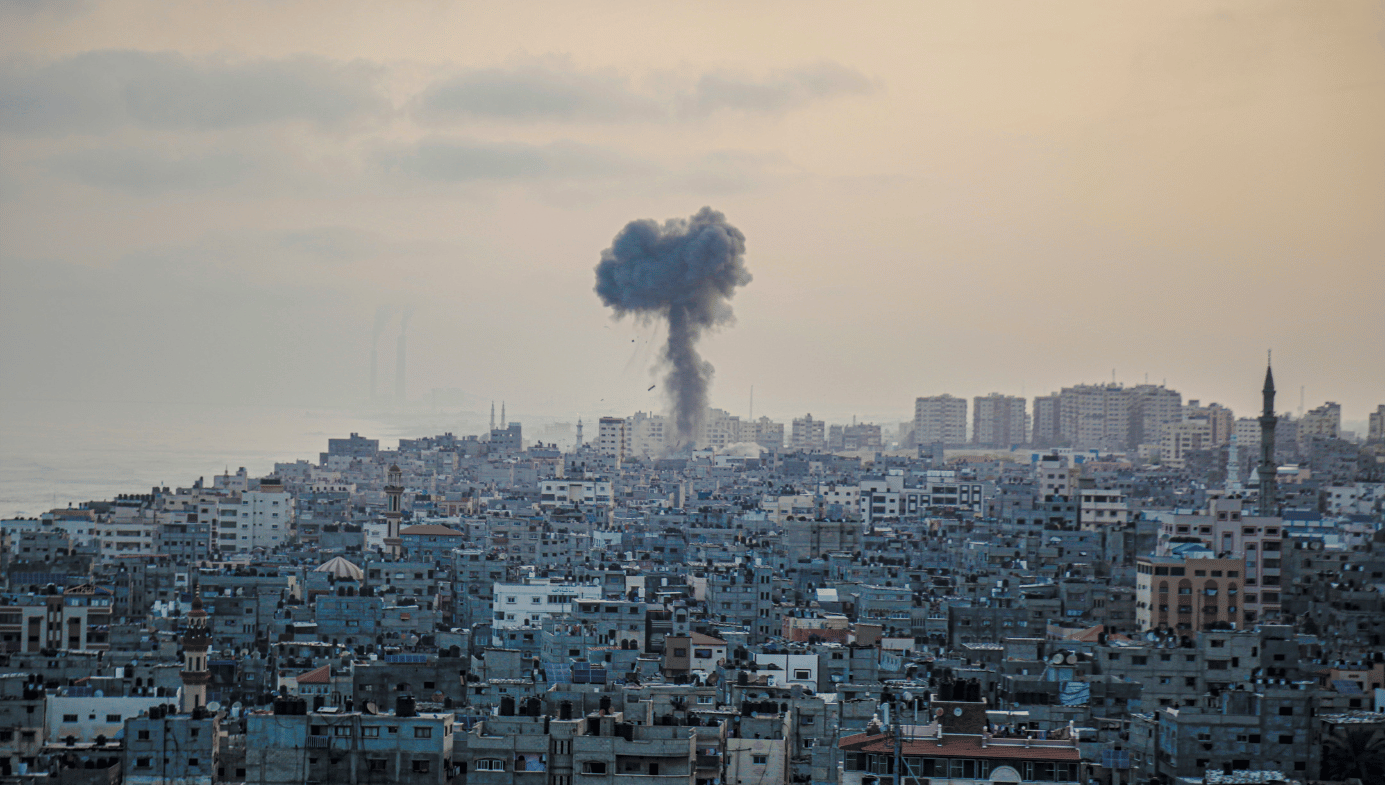Israel
Israel’s Grim Future: Attrition on All Fronts
The Jewish state is facing security threats from groups based in Gaza, the West Bank, Lebanon, and Yemen—all of them supported by Iran.

Where is the Israeli-Hamas war in Gaza heading? The short—and dismal—answer: an open-ended, multi-front war of attrition, which will sap Israel’s energy and continue to destabilize the Middle East well into 2024 and the years beyond.
In Gaza itself, the prospect is clear. In coming days, Israel will complete its occupation (and, in many areas, destruction) of the northern third of the Gaza Strip, which includes Gaza City, Beit Hanoun, and Beit Lahia. They will also fully subdue the refugee camps at the center of the strip—Nuseirat and Bureij— and Khan Yunis, the second largest urban center in Gaza.
(It should be noted that the term “refugee camp,” while commonly used in this context, is a misnomer: These are, in fact, suburban slums populated by the descendants of refugees who were driven out of what is now Israel 75 years ago.)
If given the time to complete their work by the international community—meaning, effectively, U.S. President Joe Biden—the Israel Defense Forces (IDF) will push into the southern end of Gaza, where they will take control of Rafah and the 12-kilometer length of the Gaza-Egypt border. Hamas fighters have no anti-aircraft capabilities, and will be crushed by an Israeli military whose combined-arms capabilities include state-of-the art tanks, well-trained assault engineers, and abundant air power. Given enough time, this Israeli military campaign will effectively dismantle Hamas’ control of Gaza, though the associated ideology, and its believers, will remain.

But thanks to the underground network of surviving concrete tunnels and bunkers that lie beneath Gaza’s towns and “refugee camps,” scattered squads of Hamas fighters will still be able to use small arms and explosive devices to attack the IDF units that Israel will leave inside Gaza after the main campaign is over. Eliminating this threat, Israel’s generals have admitted, will take months, and maybe years, of dangerous counter-insurgency operations. Inevitably, Israel will sustain many more casualties, on top of the more than 100 soldiers who’ve already died in Gaza over the last two months.
Israeli Prime Minister Benjamin Netanyahu has been vague about who he wants to control Gaza once Israeli forces leave. There are currently no good candidates. The Palestinian Authority (PA)—the more secular political institution that emerged from Yasser Arafat’s Palestine Liberation Organization (PLO) and its dominant Fatah faction—has only tenuous control over much of the West Bank. And opinion polls show that the majority of Palestinians—in the West Bank, East Jerusalem, and Gaza alike—support Hamas, the PLO’s bitter rival.
In any case, Netanyahu opposes the PA taking over the Strip; as he says the PA’s ultimate aim is the same as that of Hamas, Israel’s destruction. Moreover, western powers are unlikely to send troops to prop up an unpopular PA regime presiding over Gaza’s ruins. The same is true of Washington’s nominal Arab allies, such as Saudi Arabia, the United Arab Emirates, Jordan, and Egypt. Any arriving forces would be seen by Gaza’s 2.3-million residents (and much of the Arab world besides) as Israel’s lackeys. They’d likely face an insurgency soon after arriving, and would return home as soon as they began taking casualties (following the precedent set by the American and European forces that tried keeping the peace in Beirut in the 1980s). And so the most likely scenario is that the IDF, assisted by the Shin Bet, Israel’s internal security service, will remain in charge of Gaza for some time.
And yet, Gaza may not even prove to be the greatest of Israel’s problems in the coming months, and, probably, years. Along Israel’s northern border with Lebanon, and to a lesser degree along the adjoining Israel-Syria border, the Iranian-backed Shiite Islamist militia known as Hezbollah has been prosecuting a low-intensity war of attrition, firing rockets and mortar shells at Israeli border-hugging villages and IDF units, as well as targeting Israeli forces with effective Russian- and Iranian-made anti-tank missiles. Hezbollah commenced these attacks just hours after the post-10/7 IDF assault on Gaza had begun.
Israel has replied in kind. But these exchanges have been episodic. And so far, the two sides have limited their targeting to a depth of five-to-seven kilometers on both sides of the border, being mutually disinclined to turn this mini-war of attrition into a full-scale war.
But even though this conflict has been much smaller in scale than the war in Gaza, it has still understandably pinned down large IDF forces in the north. Moreover, the constant rocketing, along with the threat of a Hamas-like ground assault by Hezbollah, has forced some 50,000 inhabitants to leave their homes in the border-hugging Israeli villages and towns; and they now remain dispersed in the homes of relatives and in hotels in other parts of the country. The same remains true of a similar (or slightly larger) number of Israelis who’d inhabited communities near the Gaza Strip before Hamas’ October 7 terrorist attack.
In both cases, many of these “internal refugees” have made it clear that they will not return to their homes so long as Hamas and Hezbollah rockets, missiles, and suicide squads remain a threat. In the south especially, it seems that residents are done with the pre-10/7 status quo that has existed since 2007, by which the threat of rocket attacks has been part of everyday life. For the Israeli government, the elimination of the threat posed by Hamas and Hezbollah isn’t just a military imperative, but a domestic political imperative as well.
Hezbollah fields a much stronger military force than Hamas. It has an estimated 150,000 Iranian-supplied rockets and missiles that are far more accurate (and generally have longer ranges) than Hamas’ largely homemade variety.
Hezbollah’s own political calculus is complex, however, because—unlike Hamas in Gaza—the group, while politically dominant in Lebanon, isn’t the country’s only powerbroker. And a full-on war between Hezbollah and Israel would result in the destruction of much of Lebanon’s infrastructure throughout the country, not just in the areas that Hezbollah controls.
Hezbollah fields a much stronger military force than Hamas. It has an estimated 150,000 Iranian-supplied rockets and missiles that are far more accurate (and generally have longer ranges) than Hamas’ largely homemade variety.
Israeli and American (and perhaps French) diplomats are now quietly trying to persuade the Lebanese government and Hezbollah to adopt a plan whereby Hezbollah would withdraw its forces from southern Lebanon to areas north of the Litani River, which lies about 25 kilometers from the Israeli border, as originally called for by UN Security Council Resolution 1701 back in 2006.
That resolution also called for the disarming of Lebanon’s militias, including Hezbollah—something that didn’t happen, as the UN peacekeeping force assigned to southern Lebanon, UNIFIL, was neutered by Hezbollah intimidation and threats. Over the last 17 years, Hezbollah has gradually bolstered its military infrastructure in southern Lebanon, including its elite al-Hajj Radwan Force, which Israel treats as a major threat. Prior to October 7, in fact, IDF brass always believed that it was Hezbollah terrorists from Lebanon, not those dispatched by Hamas from Gaza, who were most likely to launch a massive cross-border strike.
Over the past two months, Israeli officials have decided that dealing decisively with Hezbollah, if it is to be done at all, will have to wait until Hamas is adequately subdued—as fighting a two-front war is a bad idea. But if diplomatic efforts to pacify southern Lebanon fail, Israel may be forced to conduct a full-scale invasion.
In a full-scale war, Hezbollah will rain down a fusillade that overwhelms Israel’s multi-layered anti-missile/anti-rocket defenses. If this attack causes large-scale casualties and devastation in Israel’s population centers, as seems likely, Israel’s response would be to devastate Beirut and Lebanon’s infrastructure, followed by an IDF ground invasion that could take Israeli soldiers as far north as Beirut (much as was the case in 1982, when Israel sought to root out an earlier generation of Arab rocket launchers belonging to the PLO).
But winter weather and ground conditions in Lebanon would not be favorable to Israel, especially as its forces would be under constant attack from resilient Hezbollah light infantry who are well-armed with modern anti-tank and anti-aircraft weaponry.
And even if such a campaign were successful in the short term, IDF soldiers would still find themselves in a hostile country, surrounded by Hezbollah squads hiding amidst southeast Lebanon’s wooded hills, villages, caves, underground bunkers and tunnels. These fighters would harry the occupying Israeli forces for months on end—yielding a second war of attrition.

Adding to the complexity of Israel’s strategic situation is the fact that some of the rockets hitting the Golan Heights and northern Israel have been fired by Hezbollah and other Iranian-backed militias from Syrian territory. Israel has responded with air strikes, but a ground invasion of Syria is not in the cards.
At the same time, Israel is contending with an entirely new and separate threat: Iranian-backed Houthi rebels in Yemen who’ve launched missiles and drones targeting Israel’s southern port of Eilat. As Yemen is located more than a thousand kilometers from Israel, the distances involved here are much greater than those travelled by Hamas and Hezbollah missiles. And so far, these Houthi attacks have been successfully intercepted by Israeli anti-missile batteries and Western ships stationed in the Red Sea. But Israel has been less successful countering the Houthi’s more serious threat—the interdiction of Israeli and Israel-destined shipping passing through the Bab al-Mandab Strait (which separates Yemen from Djibouti), heading to or from Eilat or—through the Suez Canal—Israel’s main ports at Haifa and Ashdod.
If the Houthi campaign is successful, Israeli and Israeli-related shipping heading to and from the Indian Ocean will be required to take a longer, and much more expensive, route around the Cape of Good Hope. If this situation continues, the economic damage to Israel, and perhaps to other maritime nations, would be enormous.
The Houthis have already attacked European vessels, the latest being a Norwegian-flagged oil tanker, and hijacked a large container ship. So far, the Americans and Europeans, like Israel, have refrained from retaliating against the Houthis’ bases in Yemen, hoping that this situation can be resolved by other means. If that doesn’t happen, this front, too, may devolve into a war of attrition.
Much closer to home, Israelis have faced periodic attacks—Israel calls it terrorism—by lone Palestinian gunmen and armed squads, inspired and often directed by Hamas, in the Israeli-occupied West Bank and Jerusalem. Two such lethal attacks occurred in the past weeks near roadblocks at entrances to Israel’s capital. The IDF has mounted continuous counter-insurgency operations, killing up to 250 West Bankers, most of them gunmen, and arresting over 2,000 during the past two months, many in the town of Jenin. Israel has blanketed the West Bank with troops and police, and so far has successfully staunched what could have evolved into a full-on rebellion (or third intifada) in the territory. Nevertheless, continued terrorist attacks seem likely, and greater violence may yet be in the cards.
In sum, the prospect for the coming months is that, after destroying Hamas’ main military formations and possibly confronting Hezbollah forces in some way, Israel will continue to fight multiple wars of attrition of indefinite duration on all fronts—in Gaza, in the north, along the Red Sea, and in the West Bank. Israelis will see this as an existential conflict. How its standing conscript army, reinforced by the now fully-mobilized reserves, its civilian population, and its economy hold up in such a multi-front conflict is an open question.
The mobilization of 20-to-40-year-old reservists, taken away from their civilian jobs, has created significant hardships, not to mention adverse psychological effects on countless Israeli families. The fact that most of the world, including Russia and China, are now explicitly or implicitly backing the Palestinians, Hezbollah, and the Houthis will add to Israelis’ sense of isolation and siege. Just this week, the UN General Assembly voted in favour of a “ceasefire” in Gaza—in effect seeking to deny Israel the right to finish subduing a terrorist group that murdered more than 1,200 people on October 7. At the (more powerful) Security Council, meanwhile, only a U.S. veto has served to block a resolution putting this demand into force.
Is there a way out for Israel? If so, the path likely leads through Tehran. Iran, like Hamas and Hezbollah, has long avowed that its goal is Israel’s destruction. All of Israel’s peripheral antagonists are either Iranian-directed or -supported. Certainly, the Houthis would never have dared shut down Bab al-Mandab without Iran’s authorization; and the same is true of Hezbollah’s ongoing mini-war along the Lebanon-Israel frontier. It remains unclear to what degree Hamas’ 10/7 assault was authorized by, or co-planned with, Tehran (possibly in conjunction with Hezbollah). But it was certainly Iranian-inspired and -armed. Both Hamas and Iran were keen to undermine the then-dawning Israeli-Saudi détente and the recently signed Abraham Accords, which saw the normalization of relations between Israel and a number of Sunni Arab states.
For decades, Iran’s fundamentalist regime has used its militias to undermine Israeli and American interests in the Middle East. So far, Tehran has gotten away with it. Fearing a wider and more apocalyptic confrontation, both Washington and Jerusalem have largely refrained from retaliating against Iran proper, generally confining their attacks to its proxies.
It is high time that this changed. And recent events may well inspire Biden, and even the routinely hesitant and fearful Netanyahu, to strike at the heart of the problem, Iran itself. The facilities operated by Iran’s Islamic Revolutionary Guard Corps, the organization responsible for the projection of Iranian power in the region, are known targets; as are Iran’s naval and air bases, and underground nuclear installations, which, thankfully, have not (yet) yielded an Iranian nuclear weapon. Attacks on these assets would be morally justified and long overdue. By the time Iran finally does have the bomb, it will be too late.
Such action against Iran would not bog America down in a ground war—a prospect that, thanks to the U.S. experiences in Iraq and Afghanistan, has little appeal in Washington. Instead, the aim would be to have the superiority of American and Israeli air power—backstopped by their anti-aircraft and anti-missile defense capabilities, as a means to inhibit retaliation—serve to persuade Tehran to stop promoting murder and mayhem in the Middle East.
This may be the only way to bring true peace to Israel. When seen on a map, the threats facing the Jewish state appear to come from all points of the compass. But trace them back to their source, and each leads back to the same address.






